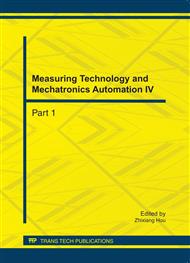[1]
Nan Liangliang, Liu Weijun, in: Three Dimensional Measuring and Data Processing in Reverse Engineering. Chengdou: CIMCTC'2007, (2007).
Google Scholar
[2]
Ma Shumei, in: Study on Key Technologies for Integrated Reverse-Engineering Faced Product Rapid Development. Shaihai: Tongji University, (2006).
Google Scholar
[3]
M. Szilvsi-Nagy, Gy. Mátyási, in: Analysis of STL files. Mathematical and Computer Modelling, 2003, 38(7): 945-960.
DOI: 10.1016/s0895-7177(03)90079-3
Google Scholar
[4]
Lin Na, Ma Zi etc, in: New Method for Calibration of Line Structure-light Vision Sensor Based on Robot System. Transducer and Microsystem Technologies, 2007, 26(9): 101-103.
Google Scholar
[5]
Zhang Yujin, in: Image Engineering (under volume)—Image Understanding and Computer Vision [M]. Beijing: Tsinghua University Press, (2000).
Google Scholar
[6]
Sato Y, Kitagawa H and Fujita H, in: Shape Measurement of Curved Objects Using Multiple Slit-ray Projections. IEEE Trans on Pattern Analysis and Machine Intell., 1982, 14(6): 641-646.
DOI: 10.1109/tpami.1982.4767318
Google Scholar
[7]
Lewandowski, Menard B and Hennequin D, in: Light Sectioning With Large Depth of Focus by Means of Fresnel Diffraction of An Edge. Opt. Engng., 1993, 32(9): 2181-2184.
DOI: 10.1117/12.145054
Google Scholar
[8]
Cheng Xiaoxue, Su Xianyu and Guo Lurong, in: Automated Method for 360 Profilometry of 3-D Diffuse Objects. Applied Optical, 1991, 30(10): 1274-1278.
DOI: 10.1364/ao.30.001274
Google Scholar
[9]
Yang Daoshan, Chen Jihong and Zhou Huicheng, in: Optical Design of Triangulation-based 3D Machine-vision System Using Line-laser. Optical Technique, 2001, 27(2): 120-122.
Google Scholar
[10]
Zong Xiaoping, Shi Shengyu and Tian Hua, in: Camera calibration for soccer robots based on BP neural network. Computer Engineering and Applications, 2008, 44(8): 204-206.
Google Scholar
[11]
Zhao Qingjie, Sun Zengqi and Lan Li, in: Neural network technique in camera calibration. Control and Decision, 2002, 17(3): 336-339.
Google Scholar
[12]
Cao Chengzhi, Zhang Kun etc, in: BP Neural Network Speed Identifier Based on Artificial Fish Algorithm. Journal of System Simulation, 2009, 21(4): 1047-1050.
Google Scholar
[13]
Zhang T. Y, Suen C. Y, in: A Fast Parallel Algorithm for Thinning Digital Patterns. Communications of the ACM, 1983, 27(3): 236-239.
DOI: 10.1145/357994.358023
Google Scholar
[14]
Du Libin, Gao Xiaohui, Xia Jinjun, Liu Hong, in: Research of a Novel 3-D Laser Scanning System. Laser Technology, 2005, 29(4): 366-369.
Google Scholar


